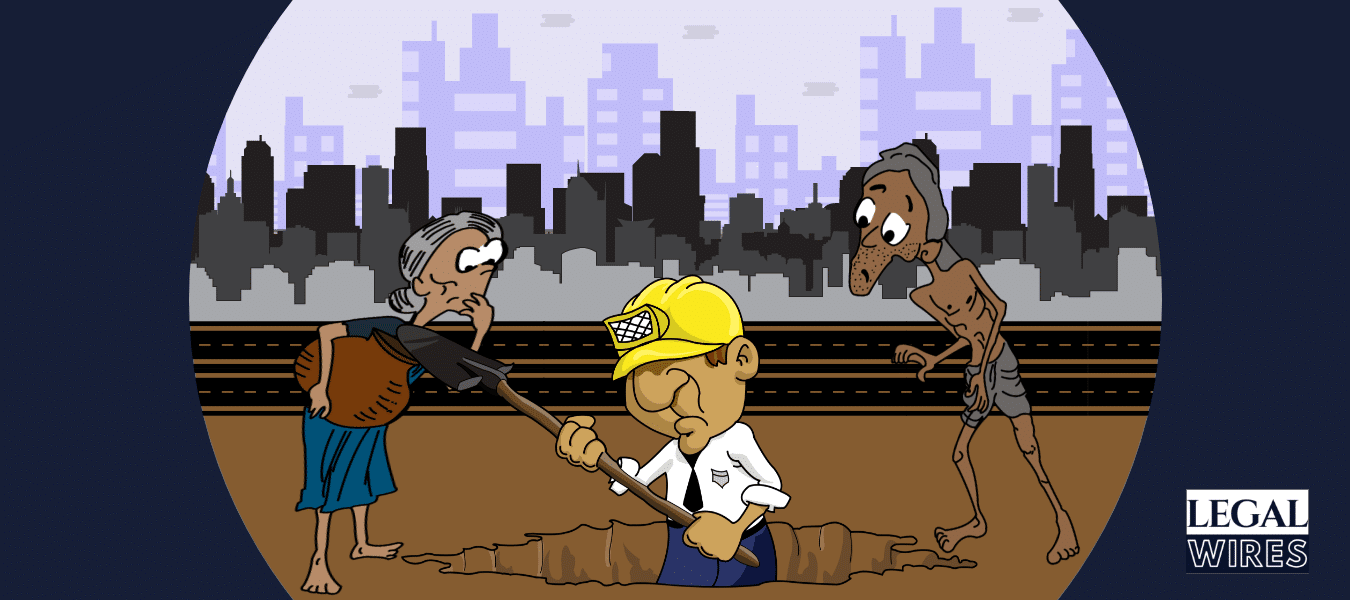Introduced in 2005 by the Government of India, MGNREGA is considered one of the world’s most efficient poverty alleviation schemes. The idea was to provide direct supplementary wage employment to the rural poor by providing them work in public sectors.

Rethinking MGNREGA: Potential and Need in the hour of COVID-19 Pandemic
Introduced in 2005 by the Government of India, MGNREGA is considered one of the world’s most efficient poverty alleviation schemes. The idea was to provide direct supplementary wage employment to the rural poor by providing them with work in public sectors. Earlier many schemes were introduced by the government of India, namely, National Rural Employment Programme, Landless employment guarantee Programme, Jawahar Rozgar Yojana, and Sampoorna Gramin Rozgar Yojana, which were implemented on a national scale. But these schemes could not meet that adequate dimension of the employment as the vision was for rural India. Though it provided some relief to them. A need was felt to provide some fixed minimum days of employment in the form of manual labour for every household in rural areas. Hence the government resolved to enact a suitable act that will provide such fixed minimum employment to every household in the rural areas in India. Therefore the National Rural Employment Guarantee (NREG) bill was proposed in parliament and commenced on 5th September 2005.
The Mahatma Gandhi National Rural Employment Guarantee Act, 2005, (MGNREGA) states its goal in its preamble[1]:
“ An act to provide for the enhancement of livelihood security of the households in rural areas of the country by providing at least one hundred days of guaranteed wage employment in every financial year to every household whose adult members volunteer to do unskilled manual work and for matters connected therewith or incidental thereto.”
In its earlier stages, the scheme was rolled out in three phases. The first phase was introduced in 200 rural districts in 2006-07. The second phase was further extended to an additional 150 districts in 2007-08 and finally, in the 3rd phase, all remaining districts were covered, with effect from 1st April 2008. MGNREGA was later renamed after Mahatma Gandhi on his birth anniversary as on 2nd October 2009 as Mahatma Gandhi National Rural Employment Guarantee Act (MGNREGA).
The main features of MGNREGA are:
- A job card is issued upon registration under the scheme by the local authority i.e. Gram Panchayat for a person of a rural household who is willing to do unskilled manual work.
- Such work has to be provided within 15 days and within 5km of the village.
- If the work is far than 5km then travel allowance is provided
- If the person does not get employment within 15 days then the person is entitled to get the unemployment wage as prescribed by the government.
The minimum wage which was initially prescribed was ₹100 in the year 2005. It was later increased gradually in subsequent years. The wages, however, differ from states to states[2]. In principle, work is measured each day, and the payment is made weekly, according to the appropriate schedule of rates for different types of work in different conditions, and deposited in their registered bank accounts.
The Union Rural Development Ministry has a notified list of types of work that are covered under MGNREGA. Majority of which concern agricultural and allied activities. The list is divided under broad head categories such as Watershed, Irrigation, and Flood management works, Agricultural and Livestock related works, Fisheries and works in coastal areas and the Rural Drinking water and Sanitation related works. The priority of work is decided by the Gram Panchayat. Overall 60:40 ratio of labour and material component will be maintained at the Gram Panchayat level for certain work based on practical requirements. The permissible work under MGREGA is categorically specified in Schedule I of the act and condition is specified in Schedule II of the act.
RELEVANCE OF SCHEME IN COVID- 19 DISTRESS
The current situation of the Indian Economy is in the midst of a slowdown. It has been slothing for long, but now it has crash-landed after being hit with the COVID-19 Pandemic. The nationwide lockdown was announced by the Prime Minister on 24th March 2020. Every sector was shut down except for very necessary ones. Hence, India’s unemployment rate surged as the lockdown crippled the economy. According to the Centre for Monitoring Indian Economy, the unemployment rate touched the whooping 27.1% on the first weekend of May[3]. The nation had to witness an unprecedented migrant worker crises in the few months of the lockdown. Over 122 million people have lost their jobs, out of which 91.3 million were small traders and labourers.[4] By the end of April, there was a huge movement of migrant workers returning to their homes. The roads and highways witnessed thousands of such labourers walking hundreds to thousands of kilometres returning their homes. Reports of many being run over by trains and highway vehicles flooded the newspaper. The exodus was driven out of hunger and helplessness, with people walking without food and water for days. In this catastrophic period, when all machinery at the disposal of state failed, MGNREGA came as the only recourse the government could resort to.
A record of 4.89 crore persons belonging to 3.44 crore households sought work under the MGNREGA in the month of May 2020. Whereas in May 2019 it was 3.18 crore, persons, from 2.26 crore households. There has been a massive surge in MGNREGA work demand due to a lack of jobs and the bereavement of the unorganized sector. A major portion of the demand came due to the witnessed phenomenon of reverse migration, where the migrant workers, were returning to their villages from the cities and industrial centres post lockdown. All the major labour exporting states have shown the highest increase in the number of households registering demand :
Uttar Pradesh: 299.3% in May 2020 against in 2019, West Bengal: 214.5%, Odisha: 113.5%, Chhattisgarh: 68.9%, Madhya Pradesh: 65.1% and Bihar 62.1%.
It has been witnessed that the agriculture sector is not that badly hit by the nationwide lockdown. Therefore, the MGNREGA scheme could easily provide employment in the agriculture sector. Since it is the peak season for Kharif crops and demand for work will be higher than usual, it is the ripe time for the government to use MGNREGA to address rural distress. It can be a saviour in the current scenario providing the security of food and livelihood for every household in rural India. The priority should be to provide immediate employment to all those in need so that they are able to meet their basic necessities.
However, it would not be a smooth sail altogether. The implementation to meet such a massive surge of demands would have its issues, given the ambit of the scheme is limited. As we generally see that the migration is from rural areas to urban in search of employment. But now it is reversed. The reverse migrants have a diverse skill set that was relevant in urban sectors but unfortunately falls short to meet the requirement of the type of works enlisted under MGNREGA. For example in a situation where a person who has been working as an employee in a hotel in Delhi seeks employment under MGNREGA after returning to his village after the lockdown, he would not be ina position to engage that efficiently in agricultural work covered under MGNREGA. Therefore the employment scheme will have to widen its ambit and scope of work provided.
MEASURES THAT CAN BE ADOPTED Suggestions have come from academicians, economists, and other experts to tailor-make the MGNREGA scheme to meet the current needs. Some of them are mentioned below:
- Many people, most prominently the labourers lost jobs and employment opportunities during April 2020. The government had urged employers to pay their employees during the lockdown and it should lead by example by compensating the 14 crore households under MGNREGA for the month of April 2020.
- The budget for MGNREGA needs to be increased to Rs. 2,50,000 or 3,00,000 crore from the current Rs 1,00,000 crore. Experts opine that around Rs 10,000 crores would be spent in settling the dues and the rest would not be enough to accommodate the increased demand for work.
- There should be no restriction on the kinds of activities allowed under the scheme as the basic idea behind the scheme is to provide work to anybody demanding it.
- The number of days in the scheme to provide guaranteed work to an adult member of any household can be exceeded above 100 days.
- The stipulation of a 60:40 wage to material cost ration can be relaxed.
- The local governments should provide adequate masks, sanitizers, and follow distancing measures to ensure the safety of the workers.
- The process of registration should be relaxed for a few months to provide work to anybody who shows up for work.
- The payment should be made in cash as the digital payment methods are not as prevalent in rural India. Part payments should be made in the form of food transfers which will help address the problem of food security to an extent and also help the government clear the excess stock of food grain that it currently holds. The Food Corporation of India as of March held a record 77 million tons of food grain, more than three times the buffer stock norm[5].
The aforementioned are some of the measures that the government can adopt to effectively address the problems of the poor. New problems call for new solutions, therefore it is recommended that the government must rethink the basic design of MGNREGA without compromising its basic objective and purpose[6]. While the country suffers and starves to death, the government cannot be a silent spectator of their miseries. It is high time that the government delivers on the ‘Acche din’ it promised. The government has a tough choice between saving lives and livelihoods but it is pertinent that the most vulnerable sections of the society are protected. The war against COVID-19 cannot be won without safeguarding the weakest and the most marginalized of the country.
[1] The Mahatma Gandhi Rural Employment Guarantee Act (MGNREGA), 2005
[2] https://nrega.nic.in/netnrega/writereaddata/Circulars/1517Revised_wage_rate.pdf
[3] MNREGA allocation now over Rs 1 lakh crore, but should be much higher due to Covid-19, SCROLL BLOG (MAY 18, 2020 3:59 PM), https://scroll.in/latest/962274/mnrega-allocation-should-be-over-rs-1-lakh-crore-says-peoples-action-for-employment-guarantee
[4] Balwant Mehta, Covid-19, and the lockdown impact: Estimating the unemployment and job losses in India’s informal economy, TIMES OF INDIA BLOG (APR. 13, 2020 11:02 AM), https://timesofindia.indiatimes.com/blogs/red-button-day-light/covid-19-and-the-lockdown-impact-estimating-the-unemployment-and-job-losses-in-indias-informal-economy/
[5] Id. at 4.
[6] The editorial, MGNREGA IN NEED, The Indian Express, June 4, 2020.



